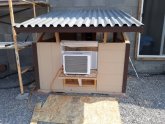Hey all
My CALB 100ah cells are going to be used for a 12v battery backup system where they will spend most of their time on float charge via the grid. As they are for a backup system I don't expect them to actually see much use.
Unfortunately they will also be in a very hot shed over an Aussie summer which will regularly reach 40C (104F) but also anything upto 50C (138F) on occasion.
The shed is NOT insulated however I will be doing my best to insulate radiant heat off the tin walls. Air conditioning or anything like that is NOT an option for me, I wish it was but it is what it is.
-What CAN I do to maximise the life of my cells?
-Should these cells not see float charge for most of their life or at the very least during our hot summer days make sure they are not seeing any charge at all;
-Should I even discharge them slightly and if so, to what voltage?
-Do I need to apply some compression in their casings?
-Should I keep the cells as seperate as possible to allow for as much cooling?
-Would a fan or any kind of passive cooling be worth the while or not really?
Has anyone seen any simple watercooling based set-ups? I don't want anything too extravagant however perhaps some waterblocks under/between the cells (I understand uniformity of the cooling will also be very important here) or a box which is entirely water-cooled?
Any tips very much appreciated.
Thanks
My CALB 100ah cells are going to be used for a 12v battery backup system where they will spend most of their time on float charge via the grid. As they are for a backup system I don't expect them to actually see much use.
Unfortunately they will also be in a very hot shed over an Aussie summer which will regularly reach 40C (104F) but also anything upto 50C (138F) on occasion.
The shed is NOT insulated however I will be doing my best to insulate radiant heat off the tin walls. Air conditioning or anything like that is NOT an option for me, I wish it was but it is what it is.
-What CAN I do to maximise the life of my cells?
-Should these cells not see float charge for most of their life or at the very least during our hot summer days make sure they are not seeing any charge at all;
-Should I even discharge them slightly and if so, to what voltage?
-Do I need to apply some compression in their casings?
-Should I keep the cells as seperate as possible to allow for as much cooling?
-Would a fan or any kind of passive cooling be worth the while or not really?
Has anyone seen any simple watercooling based set-ups? I don't want anything too extravagant however perhaps some waterblocks under/between the cells (I understand uniformity of the cooling will also be very important here) or a box which is entirely water-cooled?
Any tips very much appreciated.
Thanks



